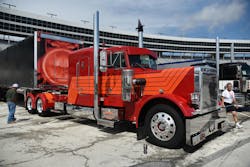FORT WORTH, Texas—While the occasional sudden, driving rains during Shell Rotella’s 42nd SuperRigs truck beauty contest made judging a bit more complicated, it never put a damper on the enthusiasm and pride of the competing drivers.
For the contest, judges scored the tractors and trailer on their exterior appearance, design, detail/finish, originality, and workmanship. And while the judges didn’t expect every truck to be blemish-free given the rough-and-tumble nature of their jobs, they did want to see how each driver handled the battle scars their rigs earned.
“With a truck that has two-and-a-half million miles on it, a little wear and tear tells a story,” said Eric Harley, one of three judges for the 2024 competition.
And given the inclement weather, many drivers had plenty of time to demonstrate their tips on how to keep their trucks pristine, no matter what the road had to offer.
Washing and waxing
It’s no surprise that the SuperRigs competitors take washing, greasing, and waxing their trucks seriously. Kevin Benson, who’s been driving for 22 years, is a proponent for frequent washes for his white and purple-striped 2023 Peterbilt 389.
“On the daily, if I run in rain, I’ll get home and we'll wash a wash all of the lower parts of the truck, anything that's kind of shiny, so that it looks clean from across the street,” Benson said. Even on days with cloudless skies, he and two or three high-school kids that their fleet dubs ‘wash boys’ clean Benson’s truck by hand every week.
This includes careful work on the frame, too, for both aesthetics and maintenance purposes.
“I think it helps avoid rusting on the frame especially because of salt, but I don’t even want dirt around the bolts,” Benson explained. “I always hit the low stuff just to keep it maintained.”
As for waxing products, Benson used Lucas Oil’s Slick Mist Speed Wax, but said he typically uses Turtle Wax products. “That’s what my dad used,” the driver recalled.
Theresa DeSantis, third-time SuperRigs contestant (and two-time winner), also stands by frequent bucket washes for her red-and-orange, witch-themed 1985 Peterbilt 389, particularly the front, mirrors, and air cleaners of her truck. For her, her washing product of choice is Dawn dishwashing soap.
Read more: SuperRigs drivers share truck beauty tips
“It takes grease off, it takes everything,” DeSantis explained. “I always get a gallon jug of it.”
Additionally, DeSantis uses a wrap to protect her stainless-aluminum trailer from scrapes, as well as keep the temperature down in the cab.
“Anything stainless reflects the sun, so [the trailer’s] reflecting it into the bunk,” she said. “I had a vinyl wrap on the back of my truck and it actually burnt that, I had to get it rewrapped.”
Service and maintenance
Of course, a clean exterior is no good if a truck’s stuck at roadside. So most drivers at the 42nd SuperRigs were also dedicated to their truck maintenance as well.
“We service our newer motor trucks every 15,000 miles,” Benson noted. “We grease them once a month. We have dump trucks too, which we grease a little bit more often because they’re always moving.”
Benson also checks his tire pressure every week and keeps a careful eye out for cupping on the outside of his tires. Meanwhile, DeSantis also changes her fuel filters every 10,000 miles.
For Derek Bridgeman and Mike Anderson, both of Mike Anderson Trucking, preventative maintenance and inspections are a weekly endeavor.
“On rare occasion do we ever have an actual breakdown on the road,” Bridgeman stated. “One reason why these trucks stay like they do is because every week, when we get in on Friday, our trucks are run through the shop.”
Anderson, who said he’d been in a shop since he was 14, checks each of his 12 1999 Peterbilt trucks’ lights, headlights, turn signals, tires, and mileage at each of these inspections. They generally do their oil changes every 12,000-14,000 miles and grease their trucks every 5,000.
“We'll go under them, even if they don't show that they need anything, we'll go in and check the brakes, look for leaks, and look for problems before they have a problem,” Anderson noted.
He then tracks each truck’s results on paper, and also keeps an eye out for rock chips on the stainless areas. Finally, the company tends to use Blue Beacon for much of their washing, which Bridgeman says he likes to do once a week.
“I try to keep her clean, because once you can get it clean, if you can stay on top of it, it'll usually stay clean,” he asserted.







